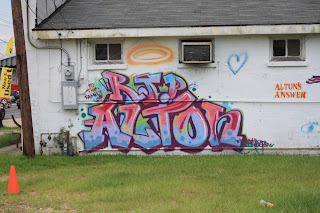The Civil Rights Institute in Birmingham
Reflections by Margaret Fair
A week ago our group paid a visit to the Birmingham Civil
Rights Institute. The exhibit opened to a Technicolor whirlwind of models and
machines emulating Civil Rights era living, but I found the succeeding area of
photos and clippings was the most meaningful to me. I found the exhibit on
student marches inspiring because it showcased the power and bravery of young
people and the importance of students (even our age) in the civil rights
movement. To see that youth were an integral part of the movement was powerful.
There was a small posting in the museum detailing jail-ins in Rock Hill, South
Carolina; this caught my attention because my extended family lives in and around
Rock Hill and my mother grew up in the area. I found it interesting and
personally meaningful to learn about the civil rights movement in the place and
time in which my mom and her siblings grew up. It made the struggle for racial
equality feel more current and proximate. The exhibit even included clippings
from the Charlotte Observer, the newspaper that my family continues to receive.
At the end of the exhibit, an area informed guests about current struggles for
equality in America and around the world and how people were using non-violent
action to combat these injustices. In particular, there was a section playing
recent popular music written for protest of injustices the artists witnessed or
experienced. As a musician, I was interested in how other musicians express
grievances of this nature. The Civil Rights Institute has an exhibit which can
speak to any person’s experience, thus making it a powerful experience for
visitors.
For me, the highlight of the pilgrimage was the Civil Rights Institute, and was, in my opinion, extremely well put together. It provided a highly immersive experience, allowing you to place yourself in the situations of the time period. One of their methods of accomplishing this was their use of realistic models. One of their models featured a scene at a diner. In it, statues of two white students sit and talk happily on bar stools, while a black student stands dejectedly outside the diner, unable to come in. The overall realism and especially the dejected expression of the black student really capture the divide between white people and people of color at the time, and the emotional repercussions of that division.
 |
| The white students at the diner |
 |
| The black student excluded from the diner |
Another model that stood out to me has one that compared a classroom for white students to one for black students in 1953. These set ups were quite detailed. The white students classroom had linoleum floors, new desks, ample school supplies, a whiteboard, and pictures of George Washington and President Eisenhower on the walls. The black students’ classroom on the other hand had concrete floors, old wooden desks, limited supplies, a chalkboard, and pictures of President Lincoln and Frederick Douglass. These models were constructed side by side, so it was easy to see the stark contrast between the two, which was rather strong.
 |
| Black classroom c. 1953 |
 |
| White classroom c. 1953 |
 |
| The caption on the display reads, "In 1944, there were 42.8 black students per teacher, and 24.3 white students per teacher." |
Another immersive feature was audio stations containing dialogue which represented pressing issues of the time. One was a mother telling her child about the importance of dignity and standing up for themselves, and another dealt with the decision a black person had to make about whether to join the movement. The fact that they were given vocal recordings made it easier to connect with than if it were just written out. All in all, the models and audio dialogue were an important feature of the Institute, and really served to create a captivating and moving museum experience.




Comments
Post a Comment